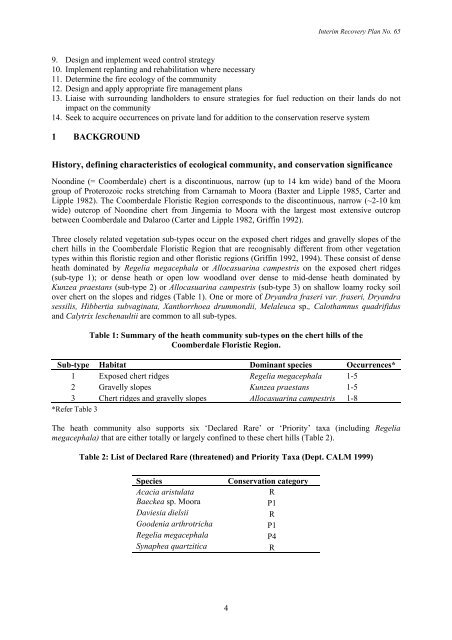Heath dominated by one or more of Regelia megacephala, Kunzea ...
Heath dominated by one or more of Regelia megacephala, Kunzea ...
Heath dominated by one or more of Regelia megacephala, Kunzea ...
You also want an ePaper? Increase the reach of your titles
YUMPU automatically turns print PDFs into web optimized ePapers that Google loves.
Interim Recovery Plan No. 65<br />
9. Design and implement weed control strategy<br />
10. Implement replanting and rehabilitation where necessary<br />
11. Determine the fire ecology <strong>of</strong> the community<br />
12. Design and apply appropriate fire management plans<br />
13. Liaise with surrounding landholders to ensure strategies f<strong>or</strong> fuel reduction on their lands do not<br />
impact on the community<br />
14. Seek to acquire occurrences on private land f<strong>or</strong> addition to the conservation reserve system<br />
1 BACKGROUND<br />
Hist<strong>or</strong>y, defining characteristics <strong>of</strong> ecological community, and conservation significance<br />
Noondine (= Coomberdale) chert is a discontinuous, narrow (up to 14 km wide) band <strong>of</strong> the Mo<strong>or</strong>a<br />
group <strong>of</strong> Proterozoic rocks stretching from Carnamah to Mo<strong>or</strong>a (Baxter and Lipple 1985, Carter and<br />
Lipple 1982). The Coomberdale Fl<strong>or</strong>istic Region c<strong>or</strong>responds to the discontinuous, narrow (~2-10 km<br />
wide) outcrop <strong>of</strong> Noondine chert from Jingemia to Mo<strong>or</strong>a with the largest most extensive outcrop<br />
between Coomberdale and Dalaroo (Carter and Lipple 1982, Griffin 1992).<br />
Three closely related vegetation sub-types occur on the exposed chert ridges and gravelly slopes <strong>of</strong> the<br />
chert hills in the Coomberdale Fl<strong>or</strong>istic Region that are recognisably different from other vegetation<br />
types within this fl<strong>or</strong>istic region and other fl<strong>or</strong>istic regions (Griffin 1992, 1994). These consist <strong>of</strong> dense<br />
heath <strong>dominated</strong> <strong>by</strong> <strong>Regelia</strong> <strong>megacephala</strong> <strong>or</strong> Allocasuarina campestris on the exposed chert ridges<br />
(sub-type 1); <strong>or</strong> dense heath <strong>or</strong> open low woodland over dense to mid-dense heath <strong>dominated</strong> <strong>by</strong><br />
<strong>Kunzea</strong> praestans (sub-type 2) <strong>or</strong> Allocasuarina campestris (sub-type 3) on shallow loamy rocky soil<br />
over chert on the slopes and ridges (Table 1). One <strong>or</strong> m<strong>or</strong>e <strong>of</strong> Dryandra fraseri var. fraseri, Dryandra<br />
sessilis, Hibbertia subvaginata, Xanth<strong>or</strong>rhoea drummondii, Melaleuca sp., Calothamnus quadrifidus<br />
and Calytrix leschenaultii are common to all sub-types.<br />
Table 1: Summary <strong>of</strong> the heath community sub-types on the chert hills <strong>of</strong> the<br />
Coomberdale Fl<strong>or</strong>istic Region.<br />
Sub-type Habitat Dominant species Occurrences*<br />
1 Exposed chert ridges <strong>Regelia</strong> <strong>megacephala</strong> 1-5<br />
2 Gravelly slopes <strong>Kunzea</strong> praestans 1-5<br />
3 Chert ridges and gravelly slopes Allocasuarina campestris 1-8<br />
*Refer Table 3<br />
The heath community also supp<strong>or</strong>ts six ‘Declared Rare’ <strong>or</strong> ‘Pri<strong>or</strong>ity’ taxa (including <strong>Regelia</strong><br />
<strong>megacephala</strong>) that are either totally <strong>or</strong> largely confined to these chert hills (Table 2).<br />
Table 2: List <strong>of</strong> Declared Rare (threatened) and Pri<strong>or</strong>ity Taxa (Dept. CALM 1999)<br />
Species Conservation categ<strong>or</strong>y<br />
Acacia aristulata R<br />
Baeckea sp. Mo<strong>or</strong>a P1<br />
Daviesia dielsii R<br />
Goodenia arthrotricha P1<br />
<strong>Regelia</strong> <strong>megacephala</strong> P4<br />
Synaphea quartzitica R<br />
4

















